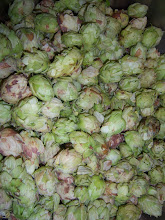
Barley’s Rye IPA was first introduced in 2005; the current version has a hazy tan color with a lacy white head and a piney, grapefruity nose. The initial feel on the palate is rather smooth and neutral; there is not much malt sweetness at the front, although there is spiciness from the rye followed by citrus, grapefruit, and pine hop flavors, before moving on to close with a nicely balanced bitterness that lingers on the back of the tongue. There is also a bit of spiciness or resin at the end as well—we were not sure if this flavor was from the rye or from the hops. While the beer could use a bit more malt in the body to balance out the large hop profile, this is still a very enjoyable beer. And on top of that, Barley’s growlers are ridiculously cheap: $11 got me a growler filled with Rye IPA to take home. I thought the bartender was undercharging me, and told him that I hadn’t brought in the growler, but he assured me that the $11 charge was correct. Lamentably, Columbus is still an hour away by car. Stupid lack of local Dayton breweries...
From Barley’s website: “Drier than our flagship IPA, Centennial IPA, Rye IPA bites back thanks
 to generous additions of Simcoe and Nugget hops. Why rye?
to generous additions of Simcoe and Nugget hops. Why rye?Necessity is not always the mother of invention. This is especially true at Barley's, where the spirit of inquiry and the pursuit of new and different styles and flavors has inspired many styles over the years.
Enter rye. This grain has a distinctive flavor, imparting a dryness and biscuit-like quality. Our first brew with rye was Angelo's Crooked Sky Rye. Now, Rye IPA.
(Why is my pant leg still rolled up? Because I'm that cool. Or an idiot. Your call.)
Rye's ability to thrive under poor soil conditions and cold temperatures has long made it a staple in the diets of Northern and Central Europeans. Although perhaps best known for its use in baked goods, rye also has a history of use in the production of whiskey, gin, and even beer. This scrappy, nutritious grain has over the years made its way into the hearts and beers of Germans, among others, and is rapidly making headway among brewers in the United States.
"Why rye?" you may ask, and not without good reason. Mention rye and the average person thinks of dense, flavorful breads and crisp crackers. Beer does not immediately leap to most minds. Yet rye makes for an interesting recipe component, contributing a distinctive, refreshing flavor; its growing presence on the beer frontier is well justified in light of its unique
 contributions to the taste and quality of beer.
contributions to the taste and quality of beer.Rye's main contribution as an ingredient is its enhancement of the overall complexity of the beer's flavor. Although the crisp, slightly spicy rye flavor does emerge somewhat distinctly (usually at the finish), at the proportions generally used it is neither too forceful nor overpowering. The subtlety of the rye flavor is due to a variety of factors, including the amount of rye used in the recipe, the form of rye used, the hopping level, the type of yeast used in the recipe, and the other ingredients involved in the brew.
In many ways, the flavor of rye beer is reminiscent of wheat beers. Light bodied and somewhat dry, rye beers tend to have a nice head and an interesting grainy, slightly spicy flavor.
Why rye? Why not?”
ABV: 5.9%
IBU (estimate): 70
OG: 1.059
Malts: British pale and American flaked rye
Bittering hops: Simcoe and Nugget
Finihsing hops: Simcoe and Nugget
Dry hops: Simcoe
First Tapped: January 15, 2005
(7/23/2009)

I say you're an idiot, but Jenn thinks it's cool. We both agree that the t-shirt is funky fresh.
ReplyDelete